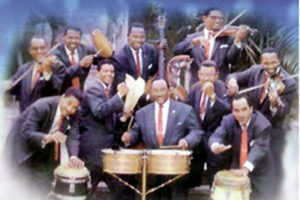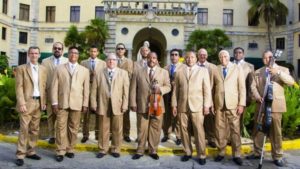
LA ORQUESTA ARAGÓN, LA ORIGINAL DE CIENFUEGOS Y SUS 85 AÑOS DE FUNDADA. PHOTOS/VIDEOS.
La Orquesta Aragón es una banda musical cubana formada el 30 de septiembre de 1939 por Orestes Aragón Cantero en Cienfuegos, Cuba cumplio otro aniversario.
La banda originalmente tenía el nombre de Rítmica 39, luego Rítmica Aragón antes de establecerse en su forma final. Aunque no crearon el Cha-cha-chá, posiblemente fueron la mejor charanga de Cuba durante los años 1950 y 1960.
Sus marcas registradas incluían instrumentistas de clase alta que tocaban en un estilo de conjunto compacto e innovaciones rítmicas que mantenían su sonido actualizado.
Con los años progresaron desde su comienzo como danzonería para tocar una variedad más amplia de estilos, danzón, luego cha-cha-chá, luego onda-chá, pachanga y fusiones de son. Todavía actúan hoy, con sede en La Habana.
RECORRIDO MUSICAL DE SU FUNDACION
En 1940 entró a la orquesta el violinista Rafael Lay, quien asumió la dirección en 1948, debido a la enfermedad del fundador de la orquesta Orestes Aragón. En 1950, luego de tocar en numerosos escenarios y emisoras de Cienfuegos, la orquesta viajó por primera vez a La Habana. En ese mismo año ingresó en la orquesta el mítico flautista Richard Egües.
En 1955 la orquesta se instala definitivamente en La Habana, bajo contrato con la Cerveza Cristal, con objeto de grabar un programa diario en Radio Progreso. Gracias a esta tradición, es que la orquesta Aragón fue invitada casi a diario, durante cincuenta años, del programa Alegrías de Sobremesa.
A finales de los años cincuenta, llevaron su música a Panamá, Venezuela, Estados Unidos y Guatemala. En 1959 se incorporó el cantante Rafael Bacallao, y poco después, en 1963, entraron el violinista Dagoberto González y en el cello, Alejandro Valdés.
En los años sesenta viajaron por Europa oriental y occidental, participaron en prestigiosos festivales de jazz, recorrieron América Latina, Japón, y varios países de África. La orquesta mantuvo su estilo, y el sonido inconfundible, a pesar de que en 1982 falleció su director Rafael Lay, y la jefatura fue asumida por Richard Egües. En 1984 tomó la batuta el violinista Rafael Lay hijo, que trabajaba en la orquesta desde 1980.
En esta época, con el triunfo del chachachá, la orquesta se transformó en uno de sus principales intérpretes y se confirmó como el conjunto por excelencia para los bailables populares. Conservaron esa categoría durante muchísimos años, hasta que Los Van Van los sustituyeron en el favor de los bailadores.
Sus mejores discos son recopilatorios como Aragón en la onda de la alegría (1988), Insuperable Orquesta Aragón (1992), Chaonda (1993), Sabrosona (1995), La charanga eterna, que es de 1999 pero fue nominada al mejor disco de música tropical tradicional en el Grammy Latino de 2002, y Los tamalitos de Olga, de 2003.
En 2005 hicieron parte de un muy singular proyecto, Cuba le canta a Serrat, y asumieron el tema No hago otra cosa que pensar en ti. Era un homenaje de los músicos cubanos (Omara Portuondo, Ibrahim Ferrer, Silvio Rodríguez, Pablo Milanés, Chucho Valdés, entre otros) al cantautor catalán.
Entre los grandes éxitos de la Orquesta Aragón, dentro y fuera de Cuba, se cuentan la decena que integran ‘Nosotros’, ‘El bodeguero’, ‘Pare cochero’, ‘Sabrosona’, ‘Cachita’, ‘Espíritu burlón’, ‘Tres lindas cubanas’. ‘El Cuini’, ‘La Muela’, y ‘Cero penas’. La mayor parte de ellas fueron compuesta por Richard Egües, en solitario o en colaboración con Rafael Lay, Silvio Contreras o Rafael Ortiz.

DISCOGRAFIA
Me Voy para la Luna Discuba DCD 520 (originally RCA, 1958)
Cha Cha Cha RCA Victor LP 1130 (1955)
That Cuban Cha Cha Cha RCA Victor LP 1294 (1956)
The Heart of Havana RCA Victor LP 1468 (1957)
Maracas, bongo y conga RCA Victor LP 1609 (1958)
Danzones de Ayer y de Hoy Discuba DCD 515 (1958)
Danzones de Ayer y de Hoy Vol 2 Discuba DCD 532 (Originally 1958)
Cojale el Gusto a Cuba Discuba DCD 502 (originally RCA, 1959)
Charangas y Pachangas Discuba DCD 555 (1959)
Ja Ja Ja Pacha Discuba DCD 557 (1961)
Ultimos exitos de la Orquesta Aragón Discuba DCD 565
Ritmo Cha-onda (Barbaro, 1978)
Mosaicos tropicales Discuba DCD 576 (1990)
La Cubanisima Orquesta Aragon (EGREM, 1992)
Quien sabe, sabe (EGREM, 1997)
La Charanga Eterna (EGREM, 1999)
En Route (EGREM, 2001)
Por Siempre Aragon (EGREM, 2002)
The Lusafrica Years (Lusafrica, 2009)
Cha Cha Chá: Homenaje a lo Tradicional (2021)
THE ORIGINAL ARAGON ORCHESTRA FROM CIENFUEGOS AND ITS 85 YEARS OF FOUNDATION. PHOTOS/VIDEOS.
The Aragón Orchestra is a Cuban musical band formed on September 30, 1939 by Orestes Aragón Cantero in Cienfuegos, Cuba celebrating this year another anniversary.
The band originally had the name Rítmica 39, then Rítmica Aragón before settling on its final form. Although they did not create the Cha-cha-chá, they were arguably Cuba’s best charanga during the 1950s and 1960s.
Their trademarks included high-class instrumentalists playing in a tight ensemble style and rhythmic innovations that kept their sound up to date.
Over the years they progressed from their beginning as a danzonería to play a wider variety of styles, danzón, then cha-cha-chá, then onda-chá, pachanga and son fusions. They still perform today, based in Havana.

With its music in the format of a charanga, and its characteristic sound of the traditional one is Cuban, the Aragón Orchestra was founded under the name of Rhythmic 39, alluding to the year of creation, then it would be called Rhythmic Aragon and, finally, Aragón Orchestra. At first, its repertoire was composed of danzones, boleros, and guarachas.
In 1940 the violinist Rafael Lay entered the orchestra, who assumed the direction in 1948, due to the illness of the founder of the Orestes Aragón orchestra. In 1950, after playing in numerous stages and stations of Cienfuegos, the orchestra traveled for the first time to Havana. In that same year, the mythical flutist Richard Egües entered the orchestra.
In 1955 the orchestra finally settled in Havana, under contract with Cerveza Cristal, in order to record a daily program on Radio Progreso. Thanks to this tradition, it is that the Aragón orchestra was invited almost daily, for fifty years, of the Alegrías de Sobremesa program.
In the late fifties, they took their music to Panama, Venezuela, the United States, and Guatemala. In 1959 the singer Rafael Bacallao joined, and shortly thereafter, in 1963, the violinist Dagoberto González entered and in the cello, Alejandro Valdés.
In the sixties, they traveled through Eastern and Western Europe, participated in prestigious jazz festivals, toured Latin America, Japan, and several countries in Africa. The orchestra maintained its style, and the unmistakable sound, although in 1982 its director Rafael Lay died, and the leadership was assumed by Richard Egües. In 1984 the violinist Rafael Lay Jr. took the baton, who worked in the orchestra since 1980.
At this time, with the triumph of the chachachá, the orchestra became one of its main performers and was confirmed as the quintessential ensemble for popular dancers. They retained that category for many years until Los Van Van replaced them in the favor of the dancers.
His best albums are compilations such as Aragón on the wave of joy (1988), Insuperable Orquesta Aragón (1992), Chaonda (1993), Sabrosona (1995), La charanga eterna, which is from 1999 but was nominated for the best music album tropical tropical in the Latin Grammy of 2002, and Los tamalitos de Olga, of 2003.
In 2005 they were part of a very unique project, Cuba sings to Serrat, and they assumed the theme I do nothing but think about you. It was a tribute to the Cuban musicians (Omara Portuondo, Ibrahim Ferrer, Silvio Rodríguez, Pablo Milanés, Chucho Valdés, among others) to the Catalan singer-songwriter.
Among the great successes of the Aragón Orchestra, inside and outside Cuba, there are the ten that make up ‘We’, ‘The Winemaker’, ‘Stop coachman’, ‘Sabrosona’, ‘Cachita’, ‘Mocking Spirit’, ‘Three beautiful Cuban ‘. ‘El Cuini’, ‘La Muela’, and ‘Zero penalties’. Most of them were composed by Richard Egües, alone or in collaboration with Rafael Lay, Silvio Contreras or Rafael Ortiz.
Agencies/ Wiki/ CiberCuba/ Joel del Rio/ AragonOrch.Hist./ Extractos/ Excerpts/ Internet Photos/ YouTube/ Arnoldo Varona.

www.TheCubanHistory.com
THE CUBAN HISTORY, HOLLYWOOD.


